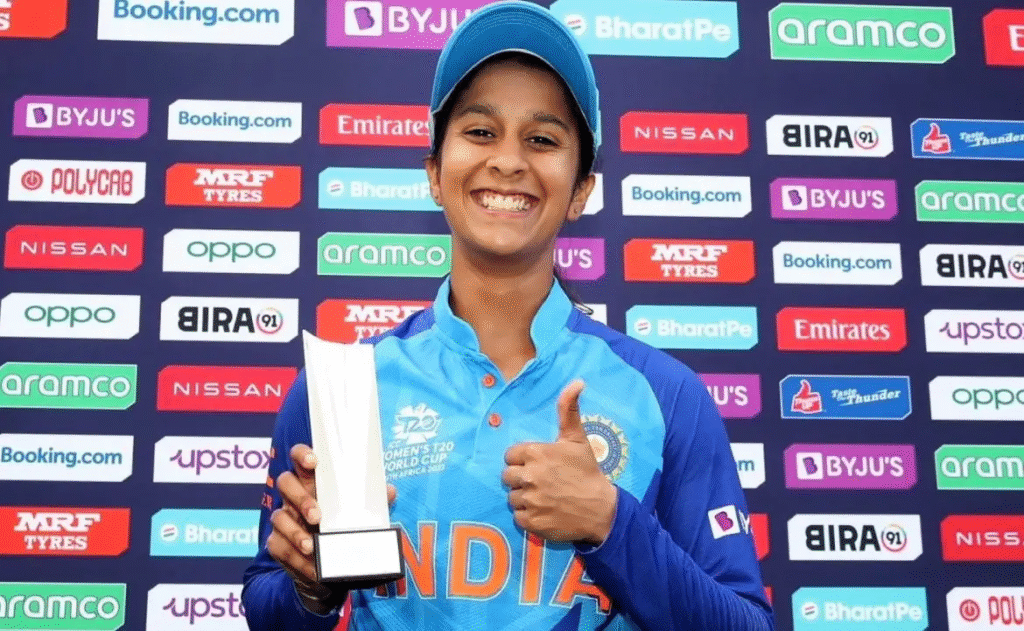
In a cricketing moment that transcended statistics and numbers, Jemimah Rodrigues reminded fans once again why she remains one of the most spirited figures in modern women’s cricket. On a warm May afternoon during the high-pressure clash in the India–South Africa–Sri Lanka Women’s Tri-Series 2025, Rodrigues unleashed a commanding innings that not only lifted her team out of early trouble but also captured the hearts of spectators and fans worldwide. Her electric century, followed by her now-iconic guitar celebration, was more than just a sporting feat—it was a declaration of confidence, artistry, and unshakeable composure under fire.
The Knock That Rewrote the Narrative
The situation was tense. The game had barely settled into its rhythm when India found itself teetering after a rocky start. With early wickets gone and South Africa applying pressure with tight lines and disciplined pace, the batting side needed more than just runs—it needed a spine, a center of calm, a player to seize momentum and dictate terms. Jemimah Rodrigues, stepping into the crease amid uncertainty, embodied that need. From the moment she took guard, her presence suggested a narrative shift. No rash shots, no panic—just calculated, elegant cricket.
It wasn’t a knock stitched together with brute force or sheer luck; it was a display of controlled aggression and razor-sharp cricketing intelligence. Her bat spoke a fluent language of cover drives, late cuts, and well-judged singles that built rhythm. The tempo of the innings started to shift. Gradually at first, then almost poetically, Rodrigues began to find boundaries with regularity. Her footwork against spin was crisp, her timing against pace effortless, and her understanding of the field placements near-perfect.
A Hundred That Meant More Than Just Numbers
When Rodrigues finally reached her hundred—a milestone clocked off in style—it wasn’t the scoreboard alone that felt the tremor. The dressing room erupted, the stadium reverberated with applause, and the millions watching from home celebrated a moment that had become increasingly rare in recent Indian women’s cricket: a young batter owning the stage with absolute authority. This was her second career century, and its importance wasn’t just in the three figures next to her name. It was in the way she constructed the innings, in the trust she earned from fans and teammates, and in the confidence she radiated across a pressure-laden atmosphere.
Even more captivating was her signature response to the moment. Removing her helmet and beaming with joy, she lifted her bat as if it were a guitar, mimicking a few strings with infectious delight. It was a celebration that has become emblematic of her unique identity—expressive, musical, full of life, and unapologetically her own.
Celebration with a Beat: The Guitar Returns
The guitar celebration has now become synonymous with Jemimah Rodrigues. Initially met with surprise and amusement during her earlier century, it has since grown into a symbolic ritual that fans await with eager anticipation. It’s not just about a gesture—it’s about what that gesture represents. Confidence, self-expression, joy, and an infectious love for the game. In an era where sports can often feel overly technical or robotic, Rodrigues offers something refreshingly human. Her celebration isn’t a gimmick; it’s a pure emotional release that resonates far beyond the boundaries of the pitch.
The cricketing world thrives on such moments—those where performance meets personality. In Rodrigues’ case, this marriage is seamless. The ‘guitar’ moment was instantly shared across social platforms, triggering fan art, memes, and a surge of interest in the tri-series that had so far flown under the radar. Rodrigues, once again, had turned a solid cricketing milestone into a cultural event.
Why This Century Matters for India’s Women’s Cricket
The century wasn’t just a personal triumph—it came at a pivotal time for India’s women’s cricket team. The tri-series had started with mixed results, and the batting unit had lacked a defining figure to build innings around. This performance changed that narrative. Rodrigues not only held the innings together but provided the exact energy and spark that had been missing in prior outings. Her ability to switch gears, read bowlers early, and rotate strike allowed others around her to settle in and perform without pressure.
For a team that’s constantly under the scanner for depth and consistency, Rodrigues’ innings was a reassuring sign that the core remains strong. It also showcased her ability to rise as a leader—not necessarily in a formal, captaincy sense, but in the unspoken, undeniable way that key performers influence the psyche of a team. When she bats with confidence, the team feeds off it.
Social Media Erupts in Applause

No great performance in modern sports goes unnoticed on social media, and Jemimah Rodrigues’ innings was no different. Within minutes of her celebration, clips of the moment flooded platforms like X (formerly Twitter), Instagram, and YouTube Shorts. Fans, influencers, and even global athletes shared praise for the unique flair she brought to the game. The hashtag #GuitarCelebration trended globally, and cricket pages lit up with montage edits and tribute reels. In an environment that thrives on engagement, Rodrigues had once again proven her magnetism.
What was particularly telling was the diversity of admiration. It wasn’t just seasoned cricket watchers lauding the shot selection or composure—it was casual viewers, young girls aspiring to play, musicians who related to her flair, and even older generations who admired the joy and freedom she expressed on the field. That kind of cross-demographic appeal is rare, and it’s what makes Rodrigues such a valuable figure—not only for Indian cricket but for the global game.
A Rising Icon in a Transforming Ecosystem
Rodrigues’ century comes at a time when women’s cricket is undergoing a transformation, particularly in India. With the introduction of the Women’s Premier League (WPL), a growing number of televised matches, better sponsorships, and an increasingly vocal fanbase, performances like hers carry new weight. They don’t just impact the scoreboard; they impact the entire narrative around the sport. And when someone delivers with both bat and personality, as Rodrigues did, it adds momentum to a movement that has long battled for visibility and respect.
She’s not just playing for runs—she’s playing for representation. Every drive, every boundary, and every celebration chips away at outdated perceptions and paves the way for a richer, more inclusive future in Indian cricket. It’s performances like these that attract attention, drive ticket sales, fuel sponsorships, and build lasting fan connections. Rodrigues, knowingly or not, is at the epicenter of that evolution.
The Road Ahead: More Than Just One Match
While the spotlight shines on this magnificent innings, the real story continues in the matches yet to come. India’s position in the tri-series is strengthened, but consistency is now key. Rodrigues has shown what she’s capable of, and expectations will naturally rise. The challenge will be maintaining that form amid shifting match conditions, opposition strategies, and mental fatigue. Yet if there’s one takeaway from this performance, it’s that Rodrigues thrives under the spotlight. She doesn’t just endure pressure—she thrives in it, plays through it, and celebrates with uncontainable joy when she breaks through.
With tournaments lined up and bigger stages awaiting, there’s every reason to believe this is just the beginning of a glorious run for Rodrigues in 2025. Fans will hope to see more of her not just for the runs, but for the excitement and energy she brings to every contest.

